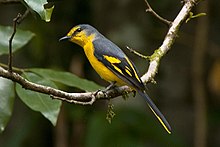| Small Minivet |
|---|
 |
| Male P. c. pallidus at Bharatpur, Rajasthan, India |
| Conservation status |
|---|

Least Concern (IUCN 3.1)
|
| Scientific classification |
|---|
| Kingdom: | Animalia |
| Phylum: | Chordata |
| Class: | Aves |
| Order: | Passeriformes |
| Family: | Campephagidae |
| Genus: | Pericrocotus |
| Species: | P. cinnamomeus |
| Binomial name |
|---|
Pericrocotus cinnamomeus
Linnaeus, 1766 |

Male
P. c. malabaricus in Shamirpet,Rangareddy district, Andhra Pradesh, India
The Small Minivet (Pericrocotus cinnamomeus) is a small passerine bird. This minivet is found in tropical southern Asia from the Indian subcontinent east to Indonesia.

Female
P. c. malabaricus in Hyderabad, India
Description
The Small Minivet is 16 cm long with a strong dark beak and long wings. The male differs from most other common minivets by having grey, not glossy black, upperparts and head, and orange underparts, fading to yellow on the belly, orange tail edges, rump and wing patches.
The female is grey above, with yellow underparts (including the face), tail edges, rump and wing patches.
There is much racial variation. The male P. c. pallidus of the northwest Indian subcontinent is pale grey above, with the underparts whitish except on the throat and flanks, whereas the male P. c. malabaricus of peninsular and southern India is darker above, has more extensive scarlet below. The female of the southern race is also brighter yellow below.
Behaviour
The Small Minivet is a widespread and common resident breeding bird in thorn jungle and scrub. The nest is a cup-like structure into which two to four spotted eggs are laid and incubated by the female.
This minivet catches insects in trees by flycatching or while perched. The Small Minivet will form small flocks. Its call is a high, thinswee swee swee.
Other views, plumages and races
Male P. c. pallidus at Bharatpur, Rajasthan,India
Male P. c. pallidus at Bharatpur, Rajasthan, India
Female P. c. pallidus at Keoladeo National Park, Bharatpur, Rajasthan, India
The southern race in Sri Lanka
Female P. c. malabaricusin Hyderabad, India
Male P. c. malabaricus in Hyderabad, India
Male P. c. malabaricus in Hyderabad, India
Female P. c. malabaricuspreening in Shamirpet,Rangareddy district,Andhra Pradesh, India























